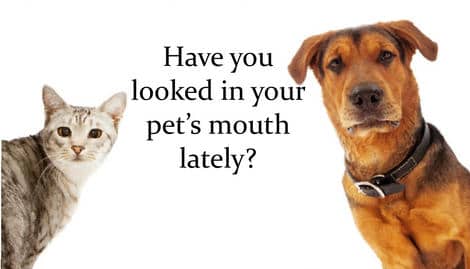 Don’t turn your nose to Fido’s or Fluffy’s bad breath! That odor might signify a serious health risk, with the potential to damage not only your pet’s teeth and gums but its internal organs as well. Small breeds and some large breeds (Greyhounds and Standard Poodles for example) are predisposed to severe dental disease. The teeth are like icebergs and occupy much of the jaw bones. When the teeth rot the jaw bone rots. The result can be serious nasal sinus abscesses and jaw fractures. Not to mention awful stinky kisses! To address the significance of oral health care for pets, the American Veterinary Medical Association (AVMA) sponsors National Pet Dental Health Month every February. According to the AVMA, up to 80 percent of dogs and 70% of cats develop oral health issues before the age of three. There are a number of signs that can help indicate whether any potential dental problems are developing, such as: * Red, swollen gums and brownish teeth * Bleeding from the mouth * Frequent pawing or rubbing at the mouth * Difficulty eating hard foods If you notice any of these signs, make an appointment with your veterinarian immediately so your pet’s teeth can be assessed.
Don’t turn your nose to Fido’s or Fluffy’s bad breath! That odor might signify a serious health risk, with the potential to damage not only your pet’s teeth and gums but its internal organs as well. Small breeds and some large breeds (Greyhounds and Standard Poodles for example) are predisposed to severe dental disease. The teeth are like icebergs and occupy much of the jaw bones. When the teeth rot the jaw bone rots. The result can be serious nasal sinus abscesses and jaw fractures. Not to mention awful stinky kisses! To address the significance of oral health care for pets, the American Veterinary Medical Association (AVMA) sponsors National Pet Dental Health Month every February. According to the AVMA, up to 80 percent of dogs and 70% of cats develop oral health issues before the age of three. There are a number of signs that can help indicate whether any potential dental problems are developing, such as: * Red, swollen gums and brownish teeth * Bleeding from the mouth * Frequent pawing or rubbing at the mouth * Difficulty eating hard foods If you notice any of these signs, make an appointment with your veterinarian immediately so your pet’s teeth can be assessed.

If you’re looking for someone who’ll go bananas every time they see your dog or cat, knows them so well they notice one hair out of place, speaks their language, knows their favorite treat AND movie and most of all become their second favorite human in the whole world, then you’ve found the right person! Lisa resides in Westerleigh and is a Dogtec Certified Dog Walker, NYC Certified in Animal Care and Handling, FEMA Animals in Disasters Certified, a Trap-Neuter-Return (TNR) and Feral Colony Care Specialist and Red Cross Pet First Aid Certified.

